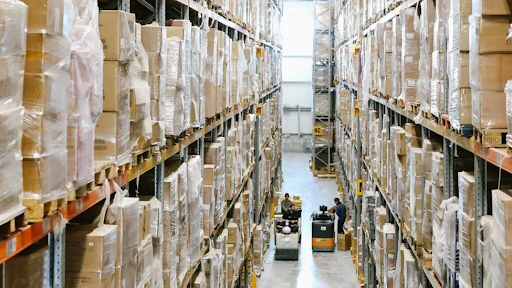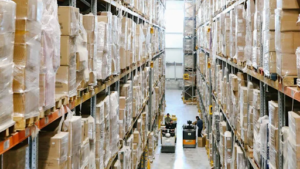Warehousing is crucial in supply chain management, assisting businesses with storage management and product distribution effectively. From small-scale setups to multinational corporations, warehousing is the backbone of logistics, ensuring products reach customers on time and in perfect condition. But what is the most crucial element of warehousing in the supply chain?
In this blog, we delve into eight key types of warehousing that have transformed logistics, streamlined processes, and are driving operational efficiency across industries.
1. Distribution Centers
Modern supply chains are incomplete without distribution centers and play a crucial role in managing inventory and speeding up delivery. Unlike traditional warehouses, distribution centers are created to move goods rapidly. They temporarily store products before shipping them to retail outlets, customers, or fulfillment centers.
Amazon is the perfect example of a distributor distribution center. Its advanced logistics system and real-time inventory tracking allow it to deliver approximately 66,000 orders per hour, meeting the increasing demand for same-day and next-day delivery and making it customers’ ideal choice for online shopping.
If you’re looking to improve distribution efficiency, explore Creating an Effective Procurement Transformation Roadmap to discover strategies for optimizing operations.
2. Cold Storage Warehouses
Cool storage warehouses are adopted by industries that require strict temperature control, such as pharmaceuticals, food, and beverages. These facilities help maintain product integrity by offering refrigeration or freezing facilities.
During the COVID-19 pandemic, the efficient distribution of vaccines was reliant on cold storage facilities. It was necessary to maintain a specific temperature for these vaccines to ensure efficacy and safety during transit. Cold storage warehouses were crucial for industries dealing with perishable goods and would face significant losses due to spoilage.
3. E-commerce Fulfillment Centers
Fulfillment centers are crucial for the rapid growth of e-commerce and managing supply chain operations. These facilities assist significantly in managing inventory, processing online orders, and ensuring timely delivery to the customers.
Companies integrate automation and smart technologies into their fulfillment centers to reduce errors and increase efficiency. In the e-commerce era, where customers expect fast and timely deliveries, fulfillment centers act as a bridge between digital storefronts and customer satisfaction.
For tips on overcoming sourcing challenges in e-commerce, check out Smooth Sailing through Product Sourcing Challenges.
4. Retail Warehouses
Return warehouses are the cornerstone of business, helping businesses maintain bulk inventory while reducing Logistics costs. These facilities make the product readily available on store shells, catering to customer demands without delay.
Retail giants like Walmart use efficient warehousing systems to support their cost-cutting strategies. Stores like Walmart keep their inventory close to retail outlets, which reduces supply chain descriptions and maintains a healthy reputation with affordability and availability.
For guidance on selecting the right vendors for retail warehousing, visit 7 Pro Tips for Vendor Selection Criteria and Procurement.
5. Cross-Docking Warehouses
This type of warehousing is an Innovative strategy that eliminates the requirement for long-term storage. Goods are transferred directly from incoming logistics to outgoing transportation, eliminating the handling time and warehousing costs.
Cross-docking can reduce warehousing costs by up to 50%, making it a game-changer for supply chain optimization. Cross-docking warehouses benefit industries with high inventory turnover, such as retail and grocery change. By minimizing storage, businesses can reduce operation costs and improve delivery time.
Learn how to streamline supply chain processes like cross-docking by reading Maintaining Strong Supplier Relationships in Product Sourcing.
6. Bonded Warehouses
Bonded warehouses are an excellent choice for businesses engaged in international trade. The facilities store imported goods without immediately paying customs duties, allowing companies to delay expenses while efficiently managing the inventory.
Bonded warehouses are significant for businesses dealing with global sourcing. They help them manage cash flow and streamline operations. Goods are stored in the warehouses until they are ready for distribution or export.
Discover global versus local sourcing considerations by visiting Global Sourcing vs Local Sourcing: What to Consider?
7. Automated Warehouses
The warehousing sector has also undergone a significant change by adopting automation in the use of robotics, artificial intelligence (AI), and analysis-based software in the supply chain. It is well understood that warehouse automation can play a critical role in supply chain transformation, and its market is expected to reach $30 billion by 2025.
Automated warehouses will facilitate inventory management, reduce employee costs, and ultimately enhance efficiency.
Amazon uses robots for order picking, packing, and shipping, fast methods used in the company’s warehouses. These systems reduce the risk of human input and enhance business efficiency, thereby satisfying the needs of the international supply chain.
8. On-Demand Warehousing
On-demand warehousing offers companies flexibility to cater to temporary storage requirements. Small—to medium-scale enterprises and startup businesses can benefit from this model, especially during this seasonal Hype or during other such events that unexpectedly increase inventory demand.
This means that Flexe Connect acts as a marketplace to offer storage locations since the company does not require constant occupation. Regarding cost, companies can manage this type of warehousing model in case of variation in demand in a particular area.
To explore how sourcing companies can assist with flexible warehousing solutions, check out Why Your Business Needs a Sourcing Company.
Conclusion:
Warehousing has evolved from a simple storage solution to a dynamic and integral part of supply chain management. From temperature-controlled cold storage to cutting-edge automated facilities, these examples showcase how warehousing transforms logistics by enhancing efficiency, reducing costs, and ensuring customer satisfaction.
Looking to elevate your supply chain operations? Partner with Brand New MD for tailored warehousing and sourcing solutions that meet your business needs.
Don’t let supply chain challenges hold you back. Let Brand New MD help you streamline operations, reduce costs, and achieve unparalleled efficiency. Contact us today to learn more about our innovative services.
Embrace the power of modern warehousing and take your supply chain to the next level.










